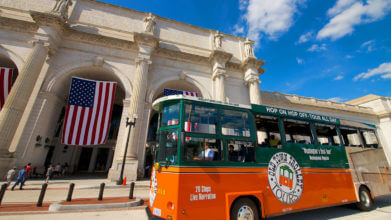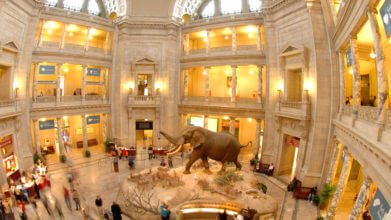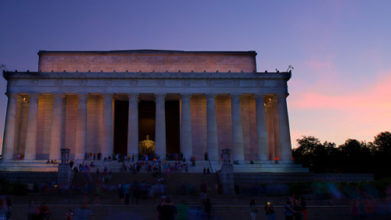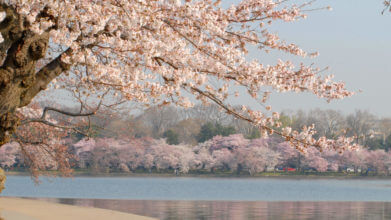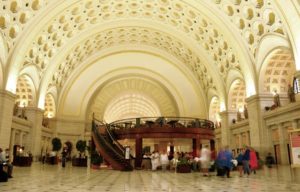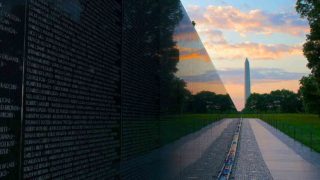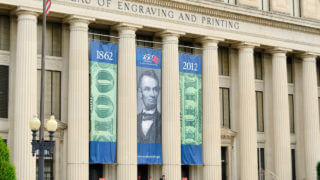Union Station
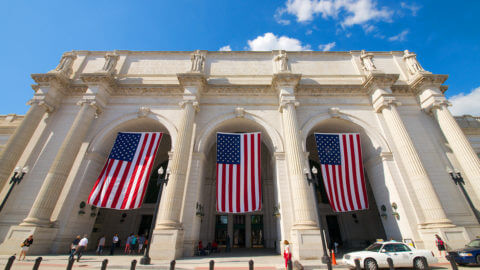
Welcome to Washington DC! The spectacular Union Station was originally designed to be the gateway to the city and since it opened over 90 years ago, has become the most visited site in DC. Its unique architecture makes it popular for photos. Locals, tourists and even presidents make it a point to visit this magnificent historic mall and train station.
Two levels feature over one hundred fabulous stores and offer shopping of every kind, from clothing to jewelry, gifts, toys, souvenirs and more. Snacks, treats and casual meals are available in the food court and several other restaurants provide delicious international fare. There’s also a 9-screen, state-of-the-art cinema on the lower level. Various cultural events and exhibits are held at Union Station throughout the year, attracting guests from around the globe. With more than 25 million people stopping in to browse, shop or just experience the excitement at Union Station each year, it still acts as the gateway to our nation’s capital.
Designed by the renowned architect Daniel Burnham, Union Station is an iconic Beaux Arts-style landmark that has served the nation’s capital for over 100 years. In addition to Amtrak trains, the intermodal depot is the focal point of commuter rail lines along with the local bus and subway system. Situated near the U.S. Capitol, the train depot is one of the city’s most popular tourist attractions. In addition to a food court, Union Station houses a more than 210,000-square-foot shopping mall that hosts companies offering various products and services, including bike and car rentals. An impressive edifice befitting its role as a portal into the nation’s capital, the station hosts a variety of international exhibits and cultural events throughout the year.
History of Union Station
In 1901, the McMillan Commission determined that further development of the National Mall would require relocating existing railroad facilities. At this time, each railroad operated its own individual depot in the city. Two years later, Congress approved the construction of a consolidated train station on the north side of Massachusetts Avenue, which facilitated the expansion of America’s “Front Yard.” The area was known as “Swampoodle” because of its boggy ground and dilapidated dwellings. The building’s front façade would be oriented toward the Capitol, which was located five blocks away. Considered one of the nation’s finest examples of Beaux Arts architecture, the station opened in 1907. While 20 tracks enter from the northeast, 12 tracks enter below ground from the south through a twin-tube tunnel that runs under Capitol Hill. The subway utilizes a nearly 900-foot-long tunnel running underneath Massachusetts Avenue. Union Station reached its peak during World War II when more than 200,000 passengers transited through the depot each day. The Beatles arrived in Union Station in 1964 to perform their first North American concert.
Rail travel waned in the late 60s as air travel became more popular. As a result, Union Station began to deteriorate. In 1976, an attempt was made to convert the train depot into a National Visitor Center, which failed and closed five years later. The same year, Congress authorized a Union Station redevelopment plan to create a vibrant shopping, dining and entertainment destination. The bill also authorized construction of new rail platforms to relocate Amtrak service inside the station. The goal of the project was to preserve the historic building for future generations while transforming it into a modern transit facility. The newly refurbished station reopened in 1988. Close to 40 million people use and visit this busy transit hub and shopping destination each year.
Must See Features
Boasting white granite and traditional Roman lines, the Neoclassical exterior façade of Union Station is modeled after the Baths of Caracalla and Diocletian as well as the Arch of Constantine. The building’s monumental style sets the tone for other structures in the city, such as the Supreme Court, the National Gallery of Art and the Lincoln Memorial. Exterior architectural details include chiseled inscriptions, Ionic columns and allegorical statues. The work of Louis Saint-Gaudens, the statues are entitled the Progress of Railroading. Ensconced in niches, the 25-ton carved figures represent agriculture, electricity, fire and mechanics as well as concepts like freedom, justice, imagination and inspiration. Interior woodwork is solid mahogany. The face of the large clock in the Main Hall has a unique feature. Instead of the Roman numeral “IV,” the clock uses “IIII.”
Measuring 120 feet by 119 feet, the Main Hall, or Head House in railroad parlance, is capped by a decorative 96-foot-high, barrel-vaulted ceiling. The coffers are decorated with egg and dart molding. The balcony is lined with 36 figures of Roman legionnaires, which were also designed by Saint-Gaudens. The hall features freestanding marble planters each weighing 10 tons. The decorations required 70 pounds of gold leaf. The antique train gates along the concourses date from 1907.
Elaborate Pompeii-style tracings adorn the walls and ceilings of the East Hall and the Columbus Club. The detailed colorful designs feature fish, fruit, griffins and geometric shapes. The walls of the Presidential Suite are painted to resemble faux leather and mahogany. The room is shaped like the White House Oval Office. Along with a replica of the presidential eagle, the suite includes elaborate polychromatic stencils. Originally created as an official reception and waiting area to prevent a reoccurrence of the 1881 assassination of President Garfield, the suite now houses a USO lounge named in honor of President Truman.
Know Before You Go
Union Station is a stop on the DC Metro Red line. The single underground island platform is located beneath the western end of the main train station. Featuring an electric vehicle charging station, a 24-hour, multi-story parking structure is connected to the train depot. It houses over 2,400 parking spaces. Union Station is also the main stop for many of the District’s sightseeing tour buses. Retail stores are open Monday through Saturday from 10 a.m. until 9 p.m. Sunday hours are noon until 6 p.m. Restaurant hours vary from 6 a.m. until 9 p.m. Monday through Saturday and 7 a.m. until 6 p.m. Sunday. Stores and restaurants may be closed New Year’s Day, Thanksgiving and Christmas.
Nearby Attractions
Adjacent to Union Station, the Smithsonian National Postal Museum opened in 1993. The museum features a variety of interactive displays that chronicle the history of the U.S. Postal Service. In addition to an extensive stamp collection, the displays also highlight mail services like direct marketing techniques from around the world. Artifacts include a horse-drawn stagecoach and an early 20th-century airmail plane.
Columbus Circle is located directly in front of Union Station. Also known as Columbus Plaza and Union Station Plaza, it is the backdrop of the Columbus Fountain. Designed by Lorado Taft and Daniel Burnham, the fountain was unveiled in 1912. It honors the explorer’s epic voyage to the New World. In addition to the flags of the District of Columbia and U.S. overseas territories, the park is ringed by state flags in the order of their admission into the Union.
Upper and Lower Senate Parks feature a reflecting pool, fountains, statuary, walking paths and shade trees. There are also several planting beds containing colorful perennials. Upper Senate Park is the setting for the Robert A. Taft Memorial and Carillon. The memorial includes a 10-foot-tall bronze statue of the former senator from Ohio along with a 100-foot-tall tower housing a 27-bell carillon. The finely tuned bells ring on the hour and quarter-hour.
A short walk from Union Station, the U.S. Capitol is open for public tours. When visiting this symbol of American democracy, you can witness the ornate ceiling of the Rotunda, Statuary Hall and the Crypt. The Capitol Visitor Center shows educational films and houses exhibits featuring rare documents and artifacts that chronicle the history of this important national landmark.
FAQs
Should I visit Union Station, DC?
Yes, Union Station in Washington, DC is a must-visit for travelers. More than just a transportation hub, it’s a stunning example of Beaux-Arts architecture filled with shopping and dining options. It’s also a starting point for exploring the city, making it a convenient and beautiful gateway to DC’s treasures.
Why is Union Station DC famous?
Union Station DC stands out not only as an iconic transportation hub but also as a historical landmark, celebrating over a century of rich history. Famous for its grandiose Beaux-Arts design, it captivates visitors with its magnificent interior, including the Main Hall’s impressive gold-coffered ceilings and marble floors. Beyond its architectural beauty, it hosts a myriad of shopping and dining experiences, art exhibits, and event spaces, making it a vibrant cultural center in the heart of Washington D.C.
What tourist attractions are near Union Station?
Just steps from Union Station, the National Gallery of Art offers a cultural feast with its extensive collection of European and American art. Nearby, the U.S. Capitol presents an impressive view and educational tours. The Smithsonian National Postal Museum, also within walking distance, enchants with its unique exhibits on postal history and stamp collection.

